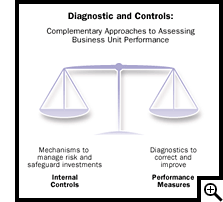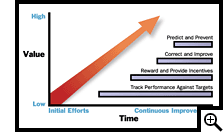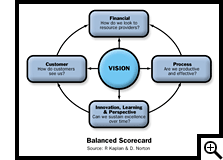






|
 |
 |
 |
 |
Assessing the soundness and effectiveness of UC business operations, both at the individual campuses and Universitywide, demonstrates the University's ongoing commitment to:10
- Set goals and assess progress in attaining them
- Identify responsibility and accountability for business processes
- Verify that efforts are producing desired outcomes
- Identify opportunities to reduce uncertainty and to improve operations
- Be responsive to the expectations and needs of those we serve
- Build a foundation for good decision-making with current, accurate information
- Share know-how and expertise among the campuses
 Measuring the performance and effectiveness of UC business and administrative units and departments consists of: Measuring the performance and effectiveness of UC business and administrative units and departments consists of:
- Measuring performance in terms of quality of service and results to the customer
- Benchmarking the performance of UC business units to similar departments or functions in other organizations
- Measuring objectives and risks in terms of business impact, timing and probability
- Measuring controls in terms of efficiency and effectiveness
Currently, the University faces several challenges that need to be addressed by the New Business Architecture:
- Performance data are not readily available in many business areas
- Organizational boundaries constrain staff's sense of ownership and responsibility for results.
- Department managers do not always recognize risks and weaknesses in the processes they manage
- Anecdotal information (versus performance data) is sometimes used to substantiate business decisions
- Identifying the cause and effect relationships that can lead to change and operational improvements is too difficult
Internal Controls
The New Business Architecture must ensure that administrative departments have current and meaningful information with which to make good decisions that will result in operational improvements and understood risk and exposure. Responsibility and accountability for financial and managerial controls must be explicit in all business processes and systems in the New Business Architecture. With increased understanding of risk and control issues within the University, a transition to a business portal-based model for the delivery of business and administrative services will ensure that reasonable monitoring and oversight mechanisms are in place and effective.
The University of California must engage in continuous self-assessment to clarify business practices and to identify opportunities for control improvement for risk factors at both the Universitywide and individual campus level. Many of the internal controls priorities identified by UC senior administrative management, both in the Office of the President and at the campuses, are critical success factors for the New Business Architecture. These include:
- Managing the impact of enrollment growth on administrative organizations;
- The continued distribution of functions and activities to the campuses;
- The increasing complexity of policy and staff guidelines; and
- The need for a comprehensive approach to employee training and development.
Other focus areas of the UC Internal Controls Initiative include proper stewardship of funds; effective management of UC sponsored research and medical center administration; and critical oversight of business partnerships with external organizations.
Internal Controls Strategies:
- Embed controls and related policies into business processes and business systems.
- Educate staff about risks and control issues in core business processes, particularly those that deliver critical or confidential information.
- Reassess internal controls regularly for proper alignment with business area strategies.
- Implement internal controls whose costs are in balance with the corresponding risk exposure.
Organizational Performance

- Build Performance Metrics into Business Processes. New and existing application systems must incorporate the tools necessary to capture, analyze and report relevant data pertaining to the overall performance of the University's business processes.
- Optimize Performance Measures and Internal Controls Mechanisms to the New Business Architecture. As staff perform more of their work via Web-based systems delivered on the desktop, performance indicators such as quality of work, effectiveness, efficiency, and customer satisfaction will take new forms. For example, measuring the time to complete a transaction may change from minutes, hours or days, to clicks of the mouse or number of times the "enter" key is hit.
- Provide Incentives, Via Financial (and Other) Recognition and Reward Systems, to Staff Who Perform at the Highest Level. When individuals, teams and units assess their operations, establish targets for improvement and achieve those targets, it is important that their efforts be appreciated and rewarded.

- Use Results for Action Planning & Intervention. When data reveal performance problems or intolerable risk in critical business processes, this information must be readily available to the unit planning process during which future priorities and action plans are established and resources are allocated.
- Communicate Results Back to Stakeholders. Administrative units should define their service commitments based on customer needs and on realistic expectations. They then must communicate these commitments to their customers and stakeholders, and report periodically on their success (or failure) to meet these performance thresholds.
- Keep It Simple & Easy to Maintain. For many departments, a simple, concise model helps to communicate both future direction and current performance. A small number of key metrics that convey results from several different perspectives suffices, in most cases, to tell the story of the unit's effectiveness. The Balanced Scorecard11 will continue to provide a useful framework for UC campuses in the future.
- Develop a Culture of Continuous Improvement. A long-term strategy to track and manage organizational performance will provide the essential links between institutional goals and individual performance criteria.
Organizational Performance Strategies:
- Build performance metrics and internal control mechanisms into UC's key business processes and optimize them to the New Business Architecture
- Use performance data to develop and implement action plans for improvement
- Pursue performance measurement methodologies (e.g. balanced scorecard) that will reinforce a culture of continuous improvement by building on the UC Partnership for Performance initiative
- Recognize and reward business unit improvement initiatives and results
- Identify mechanisms to assess the effectiveness of the New Business Architecture
| 10 |
The Partnership for Performance (http://www.ucop.edu/ucophome/businit/) is a Universitywide initiative that fosters collaboration on organizational performance measurement within business administration and operations. The University's Controls and Accountability Initiative (http://www.ucop.edu/ctlacct/) is responsible for Universitywide implementation of management and assessment strategies to ensure effective stewardship of UC resources. |
|
| 11 |
Developed by Kaplan and Norton, the balanced scorecard is a framework for strategic management of organizations. Building on the organization's vision, the balanced scorecard arrays goals and supporting performance measures in four quadrants, each of which presents a different perspective on performance: customer, financial, internal business and innovation and learning. |
|
 |
| |
|
 |
|




